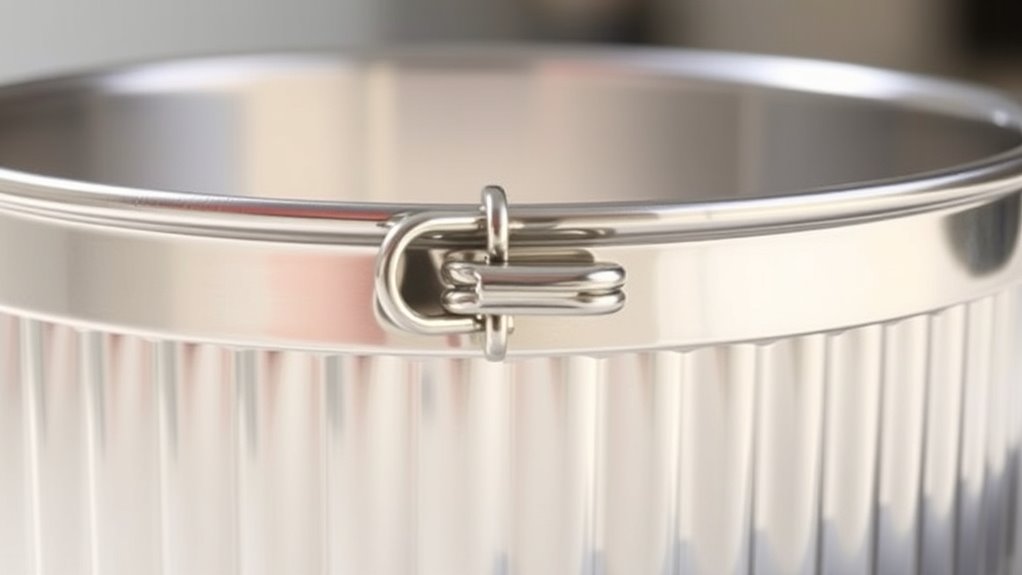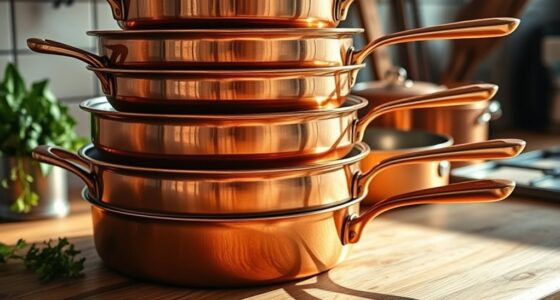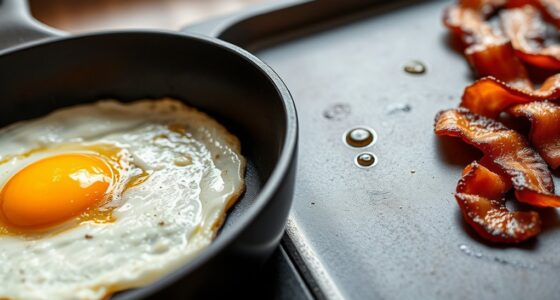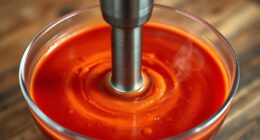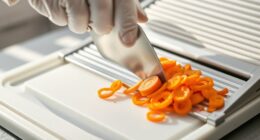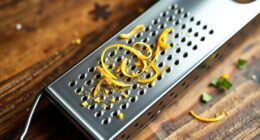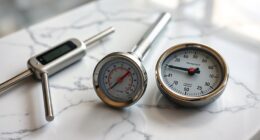To create a leak-proof setup with your springform pan, start by checking for cracks, warping, or worn seals before use. Wrap the outside in foil to prevent seepage and line the bottom with parchment paper to avoid sticking. Make sure the gasket is in good shape, and handle the pan gently during cooling. Regular maintenance and proper sealing are key. Keep exploring for more tips to perfect your baking setup.
Key Takeaways
- Inspect the pan for cracks, warping, and worn seals before use, replacing damaged parts as needed.
- Line the bottom with parchment paper and lightly grease sides if necessary to prevent sticking.
- Wrap the outside of the springform pan with multiple layers of aluminum foil to contain leaks.
- Avoid opening the oven door during baking and allow desserts to cool gradually to maintain the seal.
- Regularly clean and inspect the gasket, replacing worn seals promptly to ensure leak-proof performance.
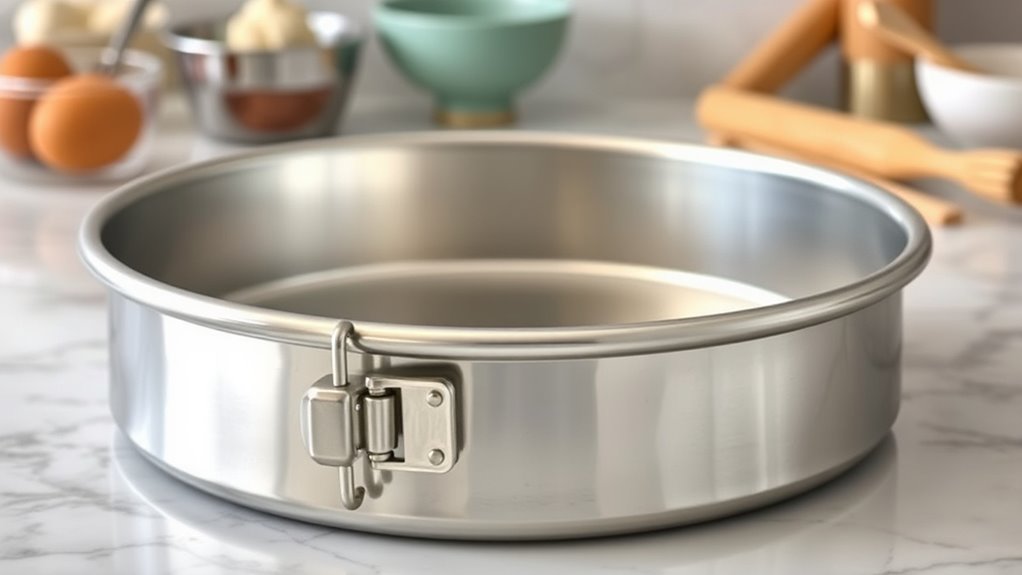
Springform pans are essential tools for bakers who want to make perfect cheesecakes, tarts, and other delicate desserts. Their unique design allows you to easily remove the baked goods without damaging their shape, but ensuring a leak-proof setup requires some careful attention. When working with springform pans, you need to follow some baking tips to prevent leaks and keep your creations looking pristine. Proper pan maintenance plays a significant role in achieving this goal. Before you start, inspect your pan for any cracks, warping, or worn-out seals. A damaged pan increases the risk of leaks and makes your baking efforts less successful. If the gasket or sealing ring is dirty or worn, replace it to maintain a secure, leak-proof environment.
When preparing the pan, lightly greasing the sides isn’t always necessary, especially if your pan has a good non-stick coating. However, some bakers prefer to line the bottom with parchment paper to prevent sticking, which also helps contain any potential leaks from the sides. To further enhance leak-proofing, consider wrapping the outside of the springform pan with aluminum foil before placing it in the oven. This extra step shields against any seepage from the sides and protects your oven from messes. Make sure the foil is snug but not overly tight—tight wrapping can distort the shape of your pan or cause leaks if the seal isn’t perfect. Additionally, using high-quality materials for your pan can significantly improve its leak-proof performance.
During baking, avoid opening the oven door unnecessarily, as sudden temperature changes can cause the pan to shift or the seal to weaken. When done, let your dessert cool gradually; rapid cooling can cause cracks or leaks. Once cooled, gently remove the sides of the springform pan, being cautious not to disturb the edges. Proper pan maintenance doesn’t end after baking—clean your pan carefully. Hand wash with warm, soapy water, avoiding abrasive scrubbers that could damage the gasket or coating. Regularly check the seal for signs of wear and replace it as needed to maintain a leak-proof environment for future baking projects.
Frequently Asked Questions
Can Springform Pans Be Used on the Stovetop?
You can’t use springform pans on the stovetop because their versatility is limited to oven baking. They’re designed for baking in the oven, not for stovetop use, which can cause leaks or damage. If you’re looking for alternative baking tools, consider a skillet or a Dutch oven for stovetop cooking. Springform pans excel in oven baking, but for stovetop tasks, choose tools specifically designed for that purpose.
Are Springform Pans Suitable for Outdoor Baking?
You can definitely give outdoor baking a whirl with springform pans, but don’t count on them to weather the storm. They’re not designed for rough weather or extreme conditions, so their weather resistance isn’t foolproof. If you plan to bake outside, use them in a sheltered spot and keep an eye on the weather. Think of it as playing it safe rather than rolling the dice with your bake.
How Do I Prevent Leaks During Baking?
To prevent leaks during baking, you should focus on sealing techniques and leak prevention tips. First, make certain the pan’s ring is securely closed, tightening it evenly to avoid gaps. Use a damp towel around the seam for extra sealing, and consider wrapping the bottom with aluminum foil for added leak protection. These steps help create a leak-proof setup, so your baked goods stay contained and your oven stays clean.
Can Springform Pans Be Used in a Microwave?
Springform pans generally aren’t microwave compatible because their materials often include metal parts like the latch or rim, which can cause sparks or damage in a microwave. If you want to use one, check if it’s made from microwave-safe materials like certain plastics or silicone. However, for best results and safety, it’s usually better to opt for microwave-safe dishes specifically designed for microwave use, avoiding metal components altogether.
What Is the Best Way to Clean a Springform Pan?
Ever notice how a quick clean can turn a stubborn springform pan into a shining star? To keep yours in top shape, start with pan cleaning by hand-washing with warm, soapy water. Use a soft sponge to avoid scratches, and for stubborn residue, try baking soda paste. Regular maintenance tips like drying thoroughly and avoiding metal utensils will extend its life and keep it leak-proof and ready for your next delicious creation.
Conclusion
Springform pans are like trusty sidekicks in your baking adventures, making cleanup easier and ensuring your desserts stay intact. With their leak-proof setup, you won’t have to worry about messes or ruined treats. Just lock the sides tightly, and you’re good to go—like sealing a treasure chest. So, embrace these pans to reveal a world of perfect, fuss-free baking, and enjoy the delicious results that come with a leak-proof, reliable tool by your side.
